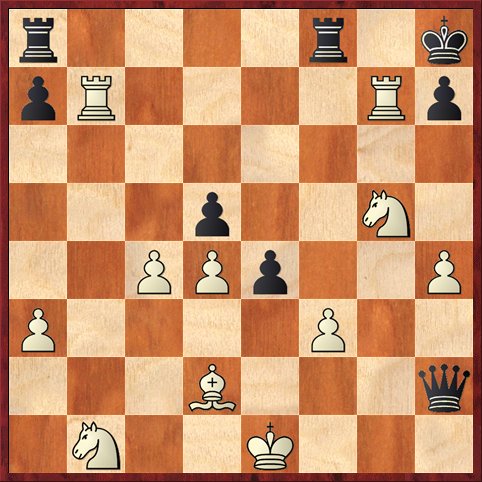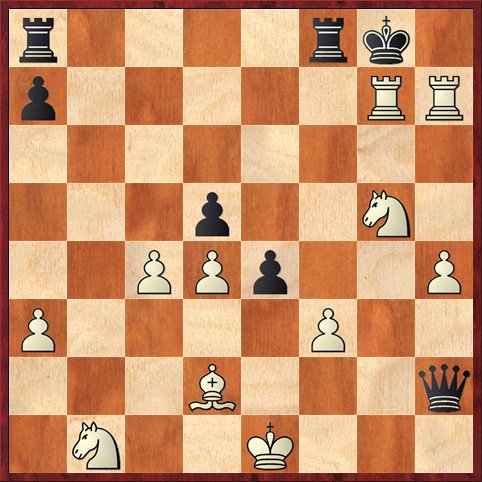Gjon Feinstein, my friend who makes his living teaching chess, has a great way to get kids over the hump of not wanting to put their pieces next to the opponent’s king, even if it would win the game. He calls it the “in-your-face” checkmate.
Today, as I do every Tuesday, I supervised the Aptos Libary chess club. Recently I have started bringing a notebook so that I can copy positions down from the kids’ games and talk about them later. In today’s meeting I set up a position from a game that was played last week.
Here White played a very poor move, 1. Rbf7?, which both loses material and loses the attack. My first question for the group today was whether anybody could find a better move for White. That was a very easy question; the kids quickly found 1. Nxg5. It’s obviously better to take the opponent’s piece than to let him take your own piece.
But that is far from being the end of the story. Next I asked them, “What does the move 1. Nxg5 threaten?” I asked them to name two specific threats. Again, they found one of them pretty quickly: White threatens 2. Nf7+, which forks the king and queen. At first they thought this was checkmate, until I pointed out that Black can play 2. … Kxg7 because the rooks are no longer connected. Still, 3. Nxd6 wins the queen for a rook. Alternatively, Black could play 2. … Rxf7, but either way he loses material.
However, no one could figure out what White’s second threat was. So I phrased the question a different way. “Suppose Black sees that you are threatening 2. Nf7+, and plays 1. … Qxh2? What would you play next?”
Well, some of the kids still wanted to play 3. Nxf7+, so I patiently explained that Black would play 3. … Kxg7 and you’ve basically given up the rook for nothing. What else can White play? Various ideas were suggested: 3. Bb4; 3. Ne6; even 3. Nxe4. Amazingly, none of the kids could see that White has a checkmate in two moves. (I didn’t tell them this, of course, because in your games no one is going to tell you it’s mate in two.)
Finally I gave them a hint: always look first at checks and captures. You would think someone would have found it then, but no! The next suggestion I got was 3. Rg8+. But this is nevertheless an interesting idea, because Black could make a mistake and play 3. … Rxg8?? (This was in fact the first defense that was suggested.) I told them there was something horribly wrong with this move, and again I suggested looking for checks and captures. That’s when someone (I don’t remember who) hit on 4. Rxh7 mate!
That’s when the light-bulb moment occurred. After I showed them this move, I mentioned that my friend calls this an in-your-face checkmate. All of a sudden, a boring lesson turned interesting to them. “In your face!” they all started chanting and saying to each other.
After letting this general celebration go on for a minute or so, I said, “Let’s go back to the previous position. Is there some way we can play an in-your-face check here?”
This time they finally caught on: “2. Rh7 check!”
“Is it a checkmate this time?”
“No!”
“Where can the Black king go?”
“To the square next to the rook.”
“Okay, 2. … Kg8. Now, can you play another in-your-face check?”
“The other rook to g7.”
“3. Rbg7+! Very good! Is it a checkmate now?”
“Yes, it is!”
Double in-your-face action
“Fantastic!” I said. “You’ve just played a double in-your-face checkmate!”
This elicited another chorus of “in your face“s. At this point I felt it was a good time to bring the lesson to an end and let the kids go back to their games. But for the remaining fifteen minutes or so, whenever I saw an opportunity for one of them to play an in-your-face check or checkmate, I would ask them if they could find it. Most of the time they did. All in all, I felt as if some kind of understanding was reached.
I learned something from this episode, too. You may understand something perfectly yourself, but that doesn’t mean that you can get someone else to see it, especially when they are between the ages of 7 and 12. But it might take just one little phrase, like “in your face,” to get the lightbulb to turn on. Of course, I can’t take any credit for this; it was Gjon’s idea. The mystery, to me, is how do you find these magic words?
P.S. By the way, if this had been a more advanced group, there is still more to talk about in the initial position. Obviously 1. … Qxh2 wasn’t such a great defense after all, since it allowed mate in two. What would be Black’s best try? (This might lead to the idea of moving the rook away from f8 to vacate the square for the king.) And after that, is 2. Nf7+ really White’s best answer, or is there possibly something even better?






{ 1 comment… read it below or add one }
Very interesting lesson for the teacher’s perspective and i found myself smiling along and approving for the spark you have ignited in the kids there!